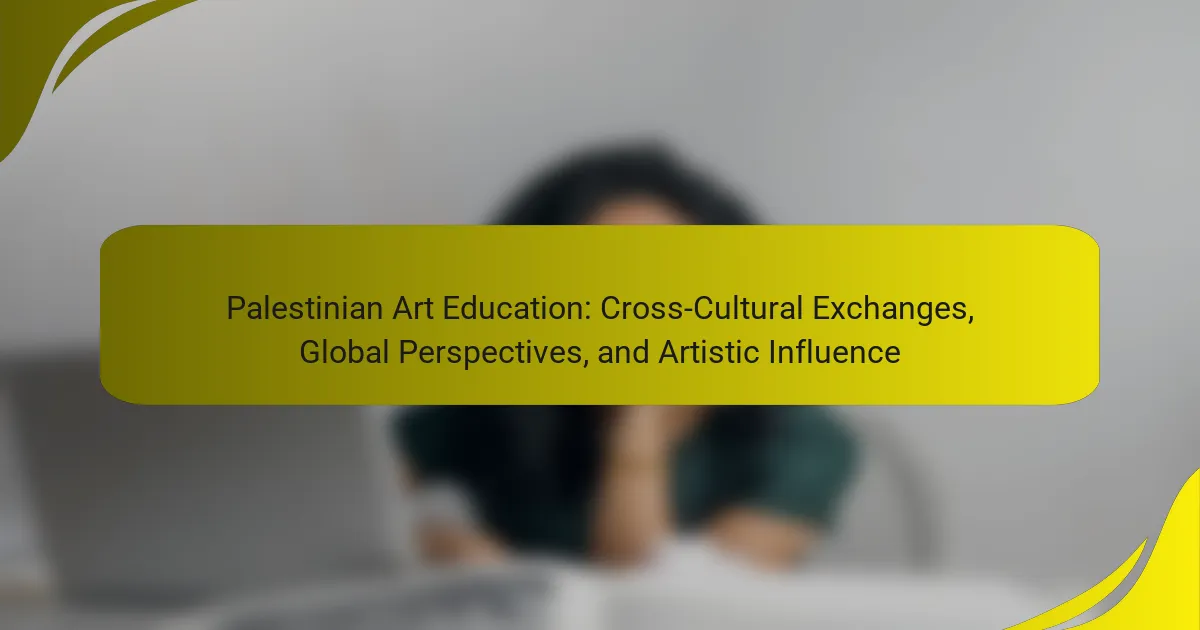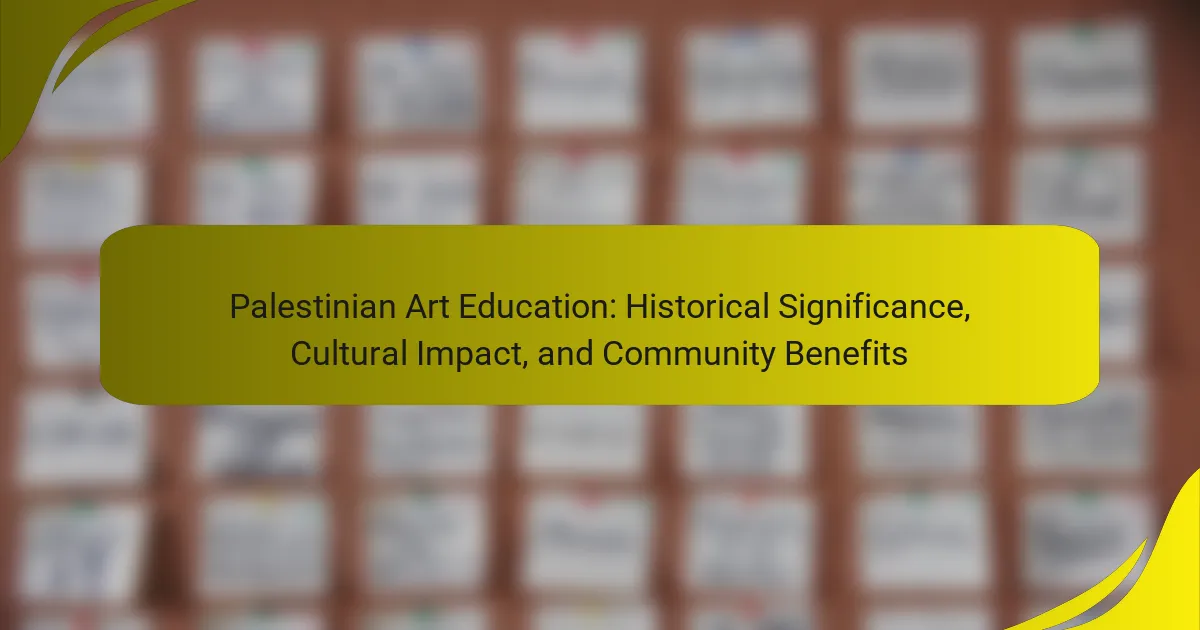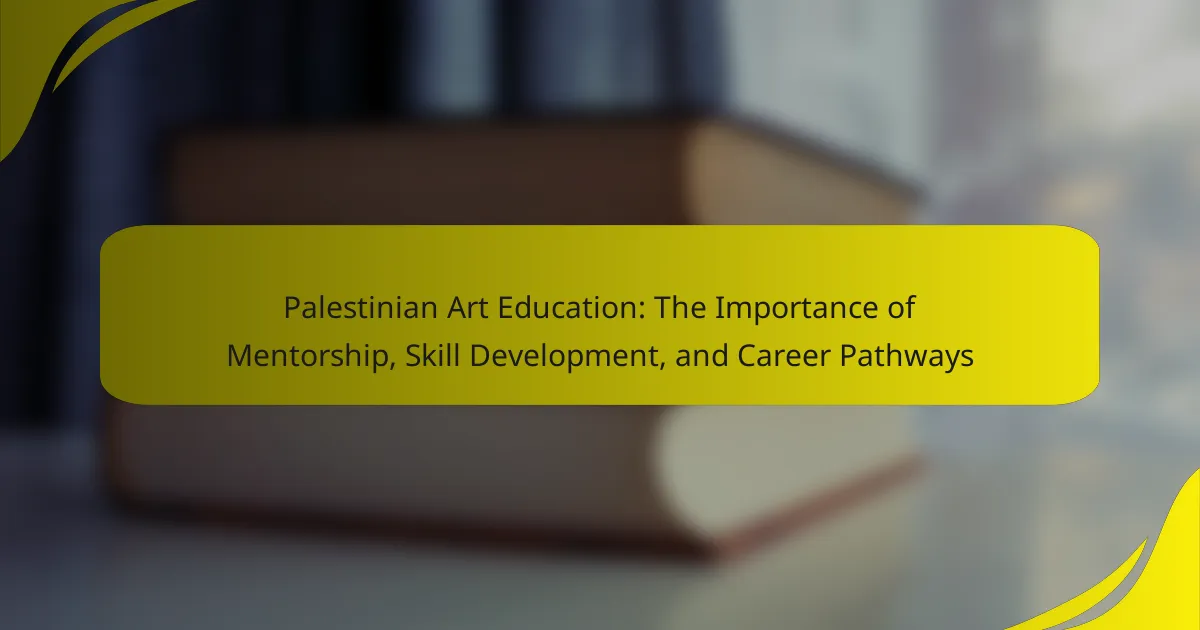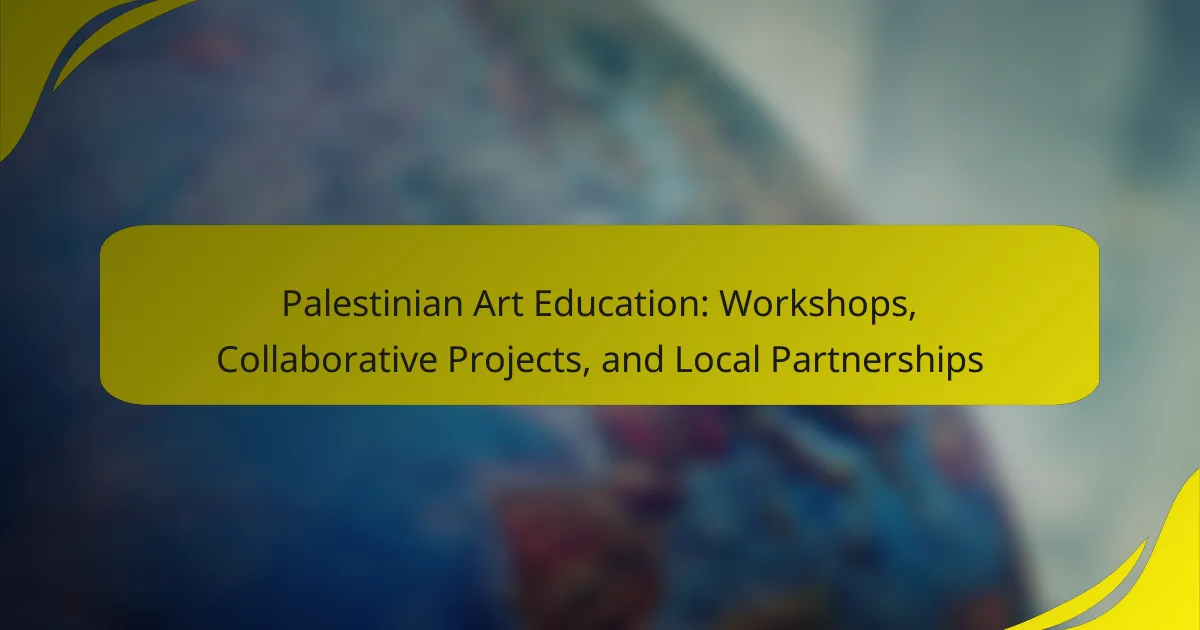Palestinian Art Education involves the structured teaching of various artistic forms, including visual arts, music, and performance, within Palestinian communities. This education aims to nurture creativity and cultural identity while addressing historical and social themes. Key institutions and organizations offer art education through schools, universities, and community programs, although challenges such as limited resources and access to materials persist. Digital platforms have emerged as vital tools to enhance accessibility, allowing for the sharing of artistic knowledge, remote learning, and global visibility for Palestinian artists. Innovative approaches, including community-based programs and virtual workshops, further promote engagement and resilience within the Palestinian art community.
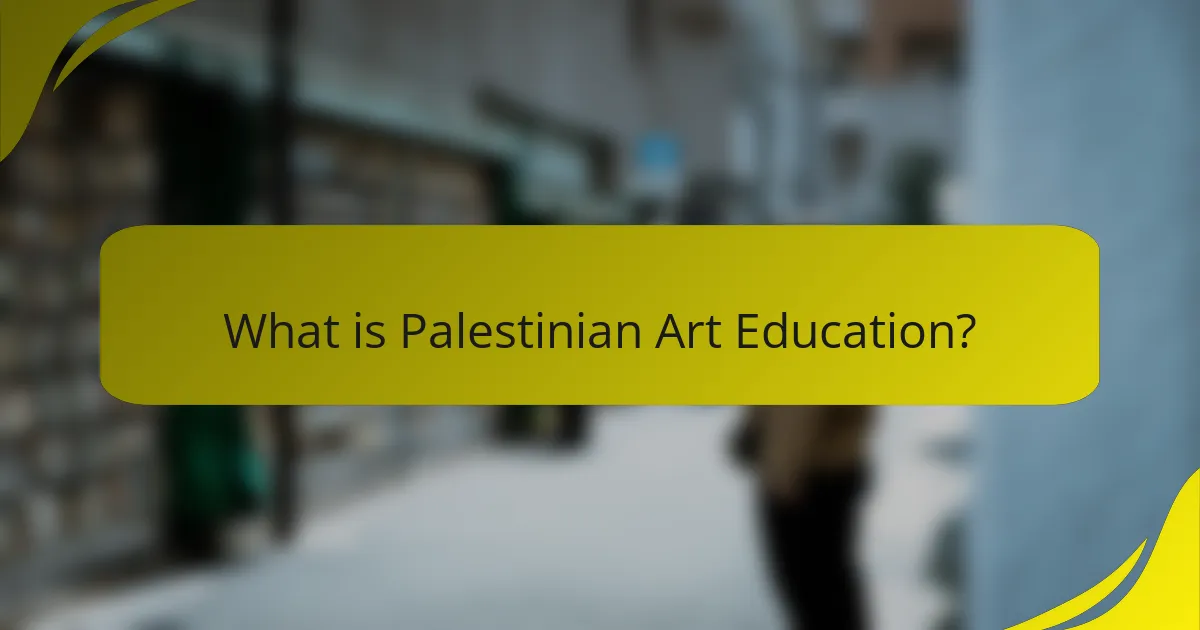
What is Palestinian Art Education?
Palestinian Art Education refers to the structured teaching and learning of art within Palestinian communities. It encompasses various forms of artistic expression, including visual arts, music, and performance. This education aims to cultivate creativity and cultural identity among Palestinians. It often addresses themes related to history, culture, and social issues. Institutions and organizations in Palestine provide art education through schools, universities, and community programs. Challenges such as limited resources and access to materials impact the effectiveness of art education. Digital platforms are increasingly used to enhance accessibility and reach a broader audience. These platforms help to overcome geographical and financial barriers in art education.
How has Palestinian Art Education evolved over time?
Palestinian Art Education has evolved significantly over time. Initially, art education in Palestine was limited and often influenced by external factors. Traditional methods dominated, focusing on local crafts and cultural heritage. In the late 20th century, the rise of institutions like the Palestine Polytechnic University introduced formal art programs. The incorporation of contemporary art practices began to reshape the curriculum. Digital platforms emerged in the 21st century, enhancing access to resources and global artistic trends. Challenges such as political instability and limited funding persist. However, innovative approaches, including online workshops and community projects, have fostered resilience and creativity among Palestinian artists.
What historical factors have influenced Palestinian Art Education?
Historical factors influencing Palestinian Art Education include the impact of colonialism, conflict, and cultural identity. The British Mandate from 1920 to 1948 introduced Western educational models. This period saw the establishment of art institutions, though often limited in scope. The 1948 Nakba led to the displacement of many artists and educators. This event significantly shaped Palestinian cultural expression and art education. The subsequent Israeli occupation further restricted educational resources and opportunities. Despite these challenges, a strong emphasis on preserving cultural identity emerged. Artists began to use their work as a form of resistance and expression. This historical context continues to affect the methodologies and themes in Palestinian art education today.
How do cultural and political contexts shape this field?
Cultural and political contexts significantly shape Palestinian art education. The ongoing conflict and political instability influence access to resources and educational opportunities. Cultural heritage plays a crucial role in shaping artistic expression and curriculum. Palestinian identity is often reflected in art, impacting teaching methods and content. Restrictions on movement affect artists and educators’ ability to collaborate and share knowledge. Digital platforms have emerged as vital tools for overcoming these barriers. They provide access to global art communities and resources. Overall, the interplay of culture and politics creates unique challenges and opportunities in this field.
What are the key components of Palestinian Art Education?
The key components of Palestinian Art Education include curriculum development, access to resources, and community engagement. Curriculum development focuses on integrating local culture and history into art education. Access to resources is often limited due to political and economic challenges. Community engagement fosters collaboration between artists and educators. Furthermore, digital platforms have emerged as vital tools for sharing knowledge and artwork. These platforms help overcome geographical barriers. Innovative approaches are also being adopted to enhance creativity and expression among students. These components collectively shape the landscape of art education in Palestine.
What types of art forms are emphasized in Palestinian Art Education?
Palestinian Art Education emphasizes various art forms including visual arts, traditional crafts, and performance arts. Visual arts include painting, drawing, and sculpture, which are foundational in teaching artistic skills. Traditional crafts such as embroidery and pottery highlight cultural heritage and artistic expression. Performance arts encompass theater and dance, promoting storytelling and community engagement. These forms are integral to fostering creativity and cultural identity among students in Palestinian art education.
How do educational institutions contribute to this field?
Educational institutions contribute to Palestinian art education by providing structured learning environments. They offer courses that enhance artistic skills and cultural awareness. These institutions often collaborate with local artists and organizations to create relevant curricula. They also facilitate access to digital platforms for wider outreach. Many schools and universities conduct workshops and seminars that promote artistic expression. Research indicates that such initiatives improve student engagement and creativity. Furthermore, educational institutions often showcase student work through exhibitions, fostering community support for the arts. These contributions are vital for preserving and promoting Palestinian cultural heritage.
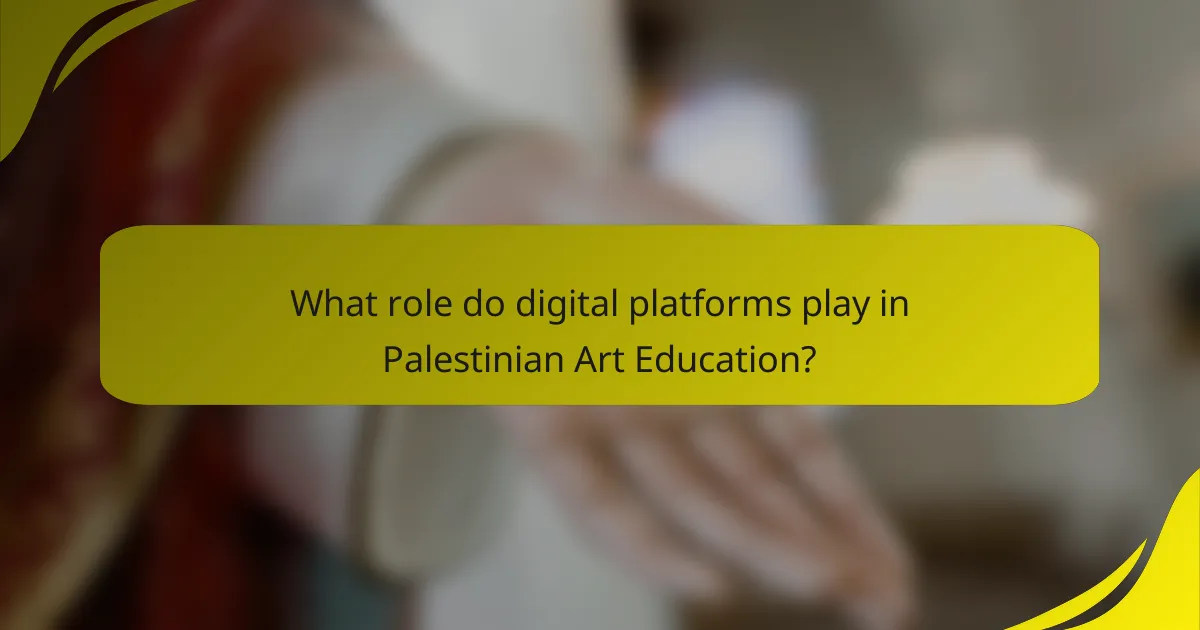
What role do digital platforms play in Palestinian Art Education?
Digital platforms play a crucial role in Palestinian art education by providing access to resources and networking opportunities. They facilitate the dissemination of artistic knowledge and practices among students and educators. Online platforms allow for the sharing of artwork, techniques, and educational materials. This enhances collaboration among artists and educators across geographical barriers. Additionally, digital platforms offer virtual workshops and tutorials, which increase participation in art education. They also help preserve and promote Palestinian cultural heritage through digital archives. The use of social media enables artists to showcase their work to a global audience, fostering greater visibility. Overall, digital platforms are essential for expanding educational opportunities in the Palestinian art community.
How are digital platforms utilized for art education in Palestine?
Digital platforms are utilized for art education in Palestine through online courses, virtual workshops, and social media engagement. These platforms provide access to art resources and tutorials that may not be available locally. They enable artists and educators to share knowledge and techniques widely. For instance, organizations like Al-Quds University offer online art classes to reach students across different regions. Social media platforms facilitate community building among artists and students. Additionally, digital exhibitions showcase Palestinian art to a global audience. This access helps overcome geographical barriers and fosters collaboration. The use of these platforms has been crucial in promoting art education amidst challenges faced in the region.
What specific digital tools and resources are available for educators and students?
Digital tools and resources available for educators and students include online learning platforms, educational apps, and collaborative tools. Popular online learning platforms are Google Classroom and Moodle. These platforms facilitate course management and communication. Educational apps like Kahoot! and Quizlet enhance interactive learning. Collaborative tools such as Microsoft Teams and Slack support group projects and discussions. Additionally, resources like YouTube and Khan Academy provide instructional videos and tutorials. These tools are widely used in various educational settings, improving engagement and accessibility for students. They support diverse learning styles and enhance the overall educational experience.
How do these platforms enhance learning experiences for students?
Digital platforms enhance learning experiences for students by providing accessible resources and interactive tools. These platforms facilitate real-time collaboration among students and teachers. They offer a variety of multimedia content, such as videos and interactive tutorials, which cater to different learning styles. Additionally, platforms often include assessment tools that enable personalized feedback. Research indicates that students using digital platforms show improved engagement and retention of information. For example, a study by the International Society for Technology in Education found that 78% of educators noted increased student participation through online learning environments. Overall, these platforms create a more inclusive and dynamic learning environment.
What challenges do educators face when using digital platforms?
Educators face challenges such as limited access to technology and internet connectivity. In regions like Palestine, infrastructure issues hinder effective use of digital platforms. Many students lack reliable internet at home, affecting participation. Additionally, educators may struggle with digital literacy. Training is often insufficient, leading to ineffective use of tools. There are also concerns about content relevance and cultural sensitivity. Digital platforms may not cater to local contexts, impacting engagement. Lastly, privacy and security issues arise when using online tools. Protecting student data is a significant concern for educators.
What accessibility issues exist for students in accessing digital art education?
Accessibility issues for students in accessing digital art education include limited internet connectivity, lack of access to devices, and inadequate digital literacy skills. Many students in Palestine face unreliable internet infrastructure, hindering their ability to participate in online classes. Additionally, some students do not have personal computers or tablets, restricting their access to digital art resources. Furthermore, a lack of training in digital tools can prevent students from effectively engaging with online platforms. According to a 2021 report by the Palestinian Central Bureau of Statistics, approximately 60% of households in Palestine lack internet access. This statistic highlights the significant barriers faced by students in pursuing digital art education.
How do socio-economic factors impact digital platform usage in art education?
Socio-economic factors significantly influence digital platform usage in art education. Access to technology is often limited by income levels. Students from lower socio-economic backgrounds may lack necessary devices or reliable internet. This results in reduced participation in online art education programs. Additionally, educational resources may not be prioritized in lower-income households. Consequently, students may miss out on valuable digital learning opportunities. According to a study by the Pew Research Center, 30% of low-income households do not have internet access. This digital divide directly affects the ability to engage with art education online.
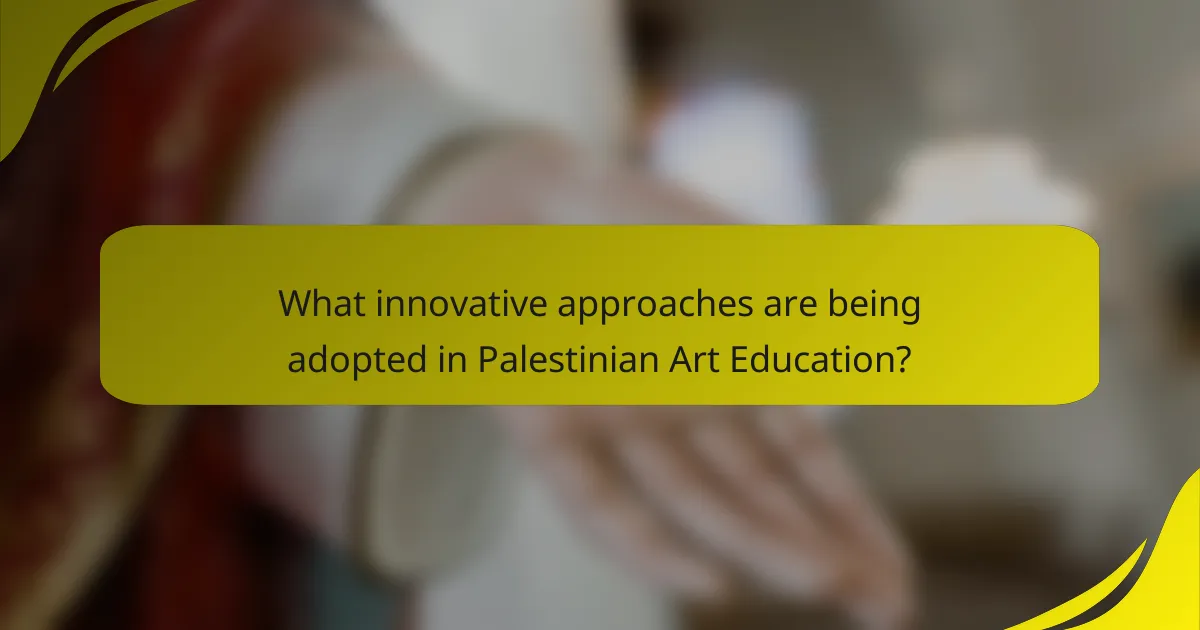
What innovative approaches are being adopted in Palestinian Art Education?
Palestinian art education is adopting innovative approaches such as digital platforms and community-based programs. These methods enhance accessibility for students and artists. Digital platforms facilitate remote learning and collaboration. They enable artists to showcase their work globally. Community-based programs promote local art initiatives and cultural exchange. Workshops and art fairs are organized to engage the community. These approaches address the challenges posed by limited resources and mobility. They foster creativity and resilience among Palestinian artists.
How are educators integrating technology into art education?
Educators are integrating technology into art education by utilizing digital tools and platforms. They employ software for digital drawing and painting, enhancing students’ creative processes. Online resources provide access to art history and techniques, broadening educational opportunities. Virtual reality (VR) is used to create immersive art experiences. Collaboration tools enable students to work together on projects, regardless of location. Social media platforms allow for sharing and critique of artwork, fostering community engagement. These integrations reflect a growing trend in art education, enhancing accessibility and interactivity. For instance, research shows that digital tools improve student engagement and learning outcomes in creative subjects.
What examples of innovative teaching methods are being implemented?
Innovative teaching methods being implemented in Palestinian art education include blended learning and project-based learning. Blended learning combines online digital media with traditional face-to-face classroom methods. This approach allows for greater flexibility and accessibility for students. Project-based learning engages students in real-world projects, enhancing critical thinking and creativity. These methods foster collaboration among students. They also encourage the use of digital platforms for sharing and showcasing artwork. Research indicates that these methods improve student engagement and learning outcomes. Studies show that active participation in projects leads to deeper understanding and retention of artistic concepts.
How do these approaches engage students in creative expression?
These approaches engage students in creative expression by utilizing digital platforms that enhance accessibility. They provide opportunities for students to share their work and collaborate with peers. Interactive tools encourage experimentation with different art forms. This fosters a sense of community and belonging among students. Research shows that digital engagement increases motivation and participation in creative activities. For instance, platforms like social media allow for immediate feedback and support. Such environments stimulate innovative thinking and artistic exploration. Overall, these approaches empower students to express themselves freely and authentically.
What collaborative initiatives exist to support Palestinian Art Education?
Collaborative initiatives supporting Palestinian Art Education include programs by organizations like the A.M. Qattan Foundation and the Palestinian Art Court. These organizations provide resources and training for artists and educators. They focus on enhancing artistic skills and promoting cultural expression. Partnerships with international institutions help facilitate workshops and exhibitions. Initiatives often emphasize accessibility and inclusivity in art education. They aim to empower young Palestinian artists and foster community engagement. Through these collaborations, art education becomes a tool for social change and cultural preservation.
How do partnerships with international organizations enhance local art education?
Partnerships with international organizations enhance local art education by providing resources, expertise, and global exposure. These collaborations enable access to advanced teaching methods and materials. For instance, organizations often supply funding for art programs and workshops. They also facilitate exchange programs, allowing local artists to learn from international peers. This exposure broadens the artistic perspectives of students and educators. Moreover, partnerships can promote cultural exchange, enriching the local art curriculum. Evidence shows that communities engaged in such collaborations often report improved student engagement and creativity. Statistics indicate that art education programs supported by international entities see higher participation rates and better outcomes.
What role do community programs play in fostering artistic talent?
Community programs play a crucial role in fostering artistic talent by providing accessible resources and support. These programs often offer workshops, mentorship, and collaborative opportunities for emerging artists. They create a platform for artists to showcase their work and gain exposure. Community programs also encourage cultural exchange and dialogue, enriching the artistic landscape. Research shows that participation in community arts initiatives leads to increased creativity and skill development. For example, a study by the National Endowment for the Arts found that community engagement enhances artistic expression and professional growth for participants.
What are some best practices for enhancing Palestinian Art Education?
Integrating digital platforms is a best practice for enhancing Palestinian Art Education. These platforms can provide broader access to resources and diverse artistic expressions. Collaborative online projects can connect Palestinian artists with global communities. Incorporating local cultural heritage into the curriculum enriches students’ understanding of their identity. Workshops led by experienced artists can foster practical skills and creativity. Establishing partnerships with art institutions can offer mentorship and exposure to professional practices. Regular exhibitions of student work can build confidence and community engagement. Lastly, providing scholarships for art students can alleviate financial barriers to education.
How can educators effectively address accessibility challenges in their teaching?
Educators can effectively address accessibility challenges by implementing inclusive teaching strategies. These strategies include using multiple formats for content delivery, such as visual, auditory, and kinesthetic methods. Providing materials in accessible formats, like large print or audio, enhances engagement. Utilizing technology, such as screen readers and captioning tools, supports diverse learning needs. Training staff on accessibility best practices is essential for fostering an inclusive environment. Collaborating with students to understand their specific needs can inform tailored approaches. Research indicates that inclusive education improves outcomes for all students, not just those with disabilities. According to the National Center for Learning Disabilities, 1 in 5 students experience learning differences, emphasizing the need for accessible teaching methods.
What strategies can be employed to leverage digital platforms for better engagement?
Utilizing interactive content is a strategy to enhance engagement on digital platforms. Interactive content includes quizzes, polls, and surveys that encourage participation. This approach fosters a two-way communication channel between educators and students. Research shows that interactive content can increase engagement rates by up to 70%.
Additionally, leveraging social media for community building is essential. Platforms like Instagram and Facebook allow for sharing artwork and educational resources. This can create a supportive network for Palestinian artists and educators. Regularly posting updates and engaging with followers can boost visibility and interaction.
Implementing live sessions or webinars is another effective strategy. These sessions provide real-time interaction and feedback opportunities. They can cover various topics relevant to Palestinian art education. Studies indicate that live video content generates 10 to 20 times more engagement than pre-recorded videos.
Creating accessible content is crucial for reaching a wider audience. This includes providing materials in multiple languages and formats. Accessibility ensures that diverse learners can engage with the content effectively. Data shows that inclusive digital content can increase participation rates significantly.
Lastly, utilizing analytics tools can help track engagement metrics. Understanding user behavior allows for tailored content strategies. Adjusting approaches based on analytics can lead to improved engagement outcomes.
Palestinian Art Education is the structured teaching and learning of art within Palestinian communities, encompassing various artistic expressions such as visual arts, music, and performance. This article explores the evolution of Palestinian art education, influenced by historical factors, cultural identity, and political contexts, while addressing challenges like limited resources and access. It highlights the significant role of digital platforms in enhancing accessibility and engagement, innovative teaching methods, and community initiatives that foster artistic talent. The discussion also covers best practices for improving art education in Palestine, focusing on leveraging technology and addressing accessibility challenges.
